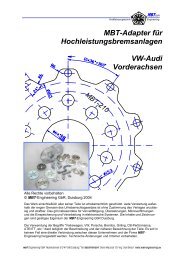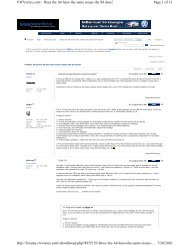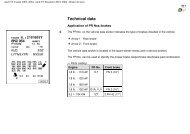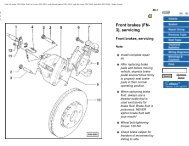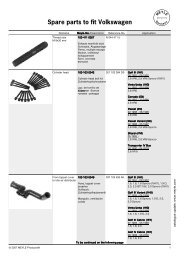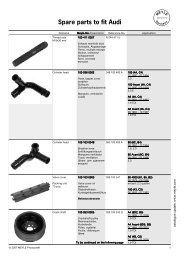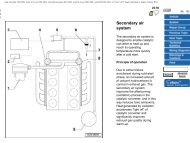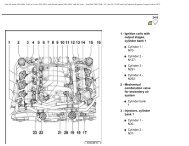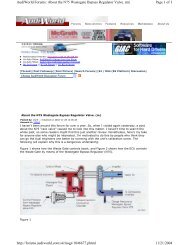VW MKII A2 MK2 Golf Jetta Fox Service Manual - VAGLinks.com
VW MKII A2 MK2 Golf Jetta Fox Service Manual - VAGLinks.com
VW MKII A2 MK2 Golf Jetta Fox Service Manual - VAGLinks.com
You also want an ePaper? Increase the reach of your titles
YUMPU automatically turns print PDFs into web optimized ePapers that Google loves.
1•10 Maintenance procedures<br />
1 Introduction<br />
This Chapter is designed to help the home<br />
mechanic maintain his/her vehicle for safety,<br />
economy, long life and peak performance.<br />
The Chapter contains a master<br />
maintenance schedule, followed by Sections<br />
dealing specifically with each task in the<br />
schedule. Visual checks, adjustments,<br />
<strong>com</strong>ponent renewal and other helpful items<br />
are included. Refer to the ac<strong>com</strong>panying<br />
illustrations of the engine <strong>com</strong>partment and<br />
the underside of the vehicle for the locations<br />
of the various <strong>com</strong>ponents.<br />
Servicing your vehicle in accordance with<br />
the mileage/time maintenance schedule and<br />
the following Sections will provide a planned<br />
maintenance programme, which should result<br />
in a long and reliable service life. This is a<br />
<strong>com</strong>prehensive plan, so maintaining some<br />
items but not others at the specified service<br />
intervals, will not produce the same results.<br />
As you service your vehicle, you will<br />
discover that many of the procedures can -<br />
and should - be grouped together, because of<br />
the particular procedure being performed, or<br />
because of the close proximity of two<br />
otherwise-unrelated <strong>com</strong>ponents to one<br />
another. For example, if the vehicle is raised<br />
for any reason, the exhaust can be inspected<br />
at the same time as the suspension and<br />
steering <strong>com</strong>ponents.<br />
The first step in this maintenance<br />
programme is to prepare yourself before the<br />
actual work begins. Read through all the<br />
Sections relevant to the work to be carried<br />
out, then make a list and gather together all<br />
the parts and tools required. If a problem is<br />
encountered, seek advice from a parts<br />
specialist, or a dealer service department.<br />
2 Intensive maintenance<br />
1 If, from the time the vehicle is new, the<br />
routine maintenance schedule is followed<br />
closely, and frequent checks are made of fluid<br />
levels and high-wear items, as suggested<br />
throughout this <strong>Manual</strong>, the engine will be<br />
kept in relatively good running condition, and<br />
the need for additional work will be minimised.<br />
2 It is possible that there will be times when<br />
the engine is running poorly due to the lack of<br />
regular maintenance. This is even more likely<br />
if a used vehicle, which has not received<br />
regular and frequent maintenance checks, is<br />
purchased. In such cases, additional work<br />
may need to be carried out, outside of the<br />
regular maintenance intervals.<br />
3 If engine wear is suspected, a <strong>com</strong>pression<br />
test will provide valuable information<br />
regarding the overall performance of the main<br />
internal <strong>com</strong>ponents. Such a test can be used<br />
as a basis to decide on the extent of the work<br />
to be carried out. If, for example, a<br />
<strong>com</strong>pression test indicates serious internal<br />
Every 1000 miles (1500 km) or monthly<br />
3 Lock, hinge and latch<br />
mechanism check 1<br />
Check the security and operation of all<br />
hinges, latches and locks.<br />
Check the condition and operation of the<br />
tailgate struts, renewing them if either is<br />
leaking or is no longer able to support the<br />
tailgate securely when raised.<br />
4 Seat belt check<br />
1<br />
1 Check the webbing of each belt for signs of<br />
fraying, cuts or other damage, pulling the belt<br />
out to its full extent to check its entire length.<br />
Check the operation of the buckles by fitting<br />
the belt tongue plate and pulling hard to ensure<br />
that it remains locked, then check the retractor<br />
mechanism (inertia reel only) by pulling out the<br />
belt to the halfway point and jerking hard. The<br />
mechanism must lock immediately to prevent<br />
any further unreeling but must allow free<br />
movement during normal driving.<br />
2 Ensure that all belt mounting bolts are<br />
securely tightened. Note that the bolts are<br />
shouldered so that the belt anchor points are<br />
free to rotate.<br />
3 If there is any sign of damage, or any doubt<br />
about a belt’s condition, it must be renewed.<br />
If the vehicle has been involved in a collision<br />
any belts in use at the time must be renewed<br />
as a matter of course and all other belts<br />
should be checked carefully.<br />
4 Use only warm water and non-detergent<br />
soap to clean the belts. Never use any<br />
5.4 Check brake fluid level warning device<br />
1081 <strong>VW</strong> <strong>Golf</strong> & <strong>Jetta</strong><br />
engine wear, conventional maintenance as<br />
described in this Chapter will not greatly<br />
improve the performance of the engine, and<br />
may prove a waste of time and money, unless<br />
extensive overhaul work is carried out first.<br />
4 The following series of operations are those<br />
most often required to improve the<br />
performance of a generally poor-running<br />
engine:<br />
Primary operations<br />
a) Clean, inspect and test the battery<br />
b) Check all the engine-related fluids<br />
c) Check the condition and tension of the<br />
auxiliary drivebelt<br />
d) Renew the spark plugs<br />
e) Inspect the distributor cap and HT leads -<br />
as applicable<br />
f) Check the condition of the air cleaner<br />
filter element, and renew if necessary<br />
g) Renew the fuel filter (if fitted)<br />
h) Check the condition of all hoses, and<br />
check for fluid leaks<br />
i) Check the idle speed and mixture settings<br />
- as applicable<br />
5 If the above operations do not prove fully<br />
effective, carry out the following secondary<br />
operations:<br />
Secondary operations<br />
a) Check the charging system<br />
b) Check the ignition system<br />
c) Check the fuel system<br />
d) Renew the distributor cap and rotor arm -<br />
as applicable<br />
f) Renew the ignition HT leads - as applicable<br />
chemical cleaners, strong detergents, dyes or<br />
bleaches. Keep the belts fully extended until<br />
they have dried naturally; do not apply heat to<br />
dry them.<br />
5 Brake check<br />
1<br />
1 Make sure that the vehicle does not pull to<br />
one side when braking and that the wheels do<br />
not lock prematurely when braking hard.<br />
2 Check that there is no vibration through the<br />
steering when braking.<br />
3 Check that the handbrake operates<br />
correctly without excessive movement of the<br />
lever and that it holds the vehicle stationary<br />
on a slope.<br />
4 Check the brake warning device for correct<br />
operation by switching the ignition on and<br />
releasing the handbrake. Now press the<br />
contact on the reservoir filler cap down and<br />
get an assistant to check that the handbrake<br />
and dual circuit warning lamp light up (see<br />
illustration).



